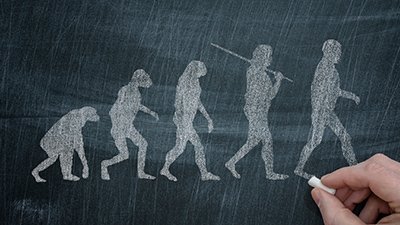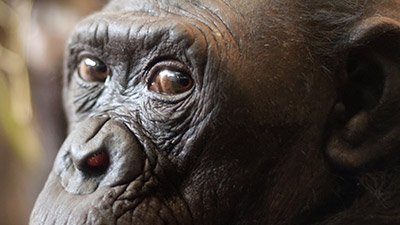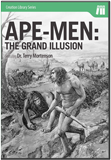Ape-Man
Making an Ape-Man
Knowing from Scripture that God didn’t create any ape-men, there are only three ways for the evolutionist to create one: 1) Combining Men and Apes, 2) Making Man out of Apes, and 3) Making Apes out of Man.
Men and Apes Homology
Homology refers to features that are similar among different animals, especially bones or DNA. For example, you may have heard that chimp and human DNA are 95–99% similar, or that our skeletons closely resemble chimp skeletons. Some people attempt to explain these similarities with evolutionary ideas.
Did Apes Become Humans?
Many may believe that there is a wide array of fossil evidence that clearly shows how apes have become humans. You have probably seen the famous depiction of a monkey progressively turning into an upright human figure. But what evidence is there for this popular picture?
Ape or Human Fossils?
In an effort to fill the gap between apes and men, certain fossil men have been declared to be “ape-like” and, thus, ancestral to, at least, “modern” man. The best known human fossils are of Cro-Magnon man and Neandertal man. Both are true men.
Articles About Ape-Man
-
Oct. 27, 2024 from Answers Magazine
If you just connect all the dots, isn’t it easy to see how the first humans could evolve from a shared ancestor with the apes?
-
Jan. 1, 2023 from Answers Magazine
No matter how hard they try, scientists can’t connect the missing links in human evolution. Why not?
-
July 14, 2020 from The New Answers Book 2
Perhaps the most bitter pill to swallow for any Christian who attempts to “make peace” with Darwin is the presumed ape ancestry of man.
-
Oct. 21, 2017 from Essays on Origins: Creation vs. Evolution
The bitterest pill to swallow for any Christian who attempts to “make peace” with Darwin is the presumed animal ancestry of man.
-
Book Chapter3.6 Human BeingsMarch 28, 2016 from Creation: Facts of Life
Despite phenomenal fossil failure, faith in evolution remains unbounded.
-
In-Depth ArticleThe Gorilla-Human “Split”: Where Do Gorillas Hang on Our Family Tree?March 10, 2016 from Answers in Depth
Researchers believe the 8-million-year age assigned to some gorilla teeth pushes back the time for the divergence of gorillas from the line that led to humans.
-
Jan. 1, 2016 from Answers Magazine
The Naledi skeletons in South Africa, whose discovery was announced last September, represent the latest species declared to be a likely human relative.
-
Magazine Department ArticleJawing with EvolutionistsJuly 1, 2015 from Answers Magazine
Who is the latest claimant to the title “oldest known human in the fossil record”?
-
In-Depth ArticleWhat Can Lucy’s Neighbors Tell Us About Human Origins?June 9, 2015 from Answers in Depth
Evolutionists welcome the new australopithecine jaws to the “hominin” family. But do we learn anything at all about human history from these fossils?
-
Oct. 1, 2014 from Answers Magazine
The effort to fill in the gaps between apelike ancestors and modern humans continues to produce some interesting stories.
-
Magazine Department ArticleThree Ways to Make an Ape-ManApril 1, 2014 from Answers Magazine
A good laugh can really make a lesson stick, as Dr. David Menton regularly demonstrates in his popular workshop “Three Ways to Make an Ape-Man.”
-
Flexi-feet: Did Some Humans Fail to Leave Them in the Trees?July 1, 2013 from News to Know
Flexible feet supposedly link humans with ape-like ancestors.
-
Changes in Diet Allegedly Drove Human EvolutionJan. 12, 2013
Environmentally driven changes in diet are said to have driven evolution of humans.
-
Bowel Bug Type Tied to Common Ape-Like AncestryNov. 24, 2012 from News to Know
Bowel bug type tied to common ape-like ancestry.
-
Primates’ Evolutionary Relationship to PeopleMay 26, 2012 from News to Know
Psychologists say observations of chimpanzee and orangutan behavior in zoos support the primates’ evolutionary relationship to people.
-
Transitional Tale Told by ToesApril 7, 2012 from News to Know
Transitional tale told by toes (and metatarsals) is full of sound and fury, signifying nothing.
-
Promethean Hypothesis from Cooking FireApril 7, 2012 from News to Know
Promethean hypothesis picks up steam from residual cooking fire.
-
Walking Up the Evolutionary TreeMarch 31, 2012 from News to Know
Are we human because we learned to walk on our own two feet . . . or do we walk upright because we’re human?
-
Sugar Molecules as Early Human Evolutionary SegregatorsOct. 15, 2011 from News to Know
Sugary sialic acid signatures seen as evolutionary segregators of early humans
-
The Developing Human Brain and EvolutionJuly 17, 2010
Does the developing human brain portray the evolution of humans from ape-like creatures?
-
Magazine Department ArticleApe vs. ManJuly 1, 2010 from Answers Magazine
An exhibit to be installed this summer at the Creation Museum near Cincinnati tackles one of the icons of evolutionary thinking: homology.
-
Ape or Human?Nov. 7, 2009 from News to Know
This week, American public broadcasting began a three-part series on human evolution titled Becoming Human.
-
Is Their Model Upright?Aug. 15, 2009 from News to Know
“This model should cause everyone to re-evaluate what they’ve said before”—the words of a Duke University professor whose research turns the origins of bipedal walking on its head.
-
The Three-Quarter Million Dollar Ape-manMay 30, 2009 from News to Know
The paleontologist who brought Ida to the media spotlight dropped a cool $750,000 (£465,000) to get his hands on it.
-
Book ChapterThe Origin of HumansMay 3, 2007 from Evolution Exposed: Biology
You have probably seen the famous depiction of a monkey progressively turning into an upright human figure.
-
TIME Article Ponders Difference Between Man and ApeOct. 7, 2006
TIME magazine’s cover story this week asked the question, “What Makes us Different?”
-
TIME to Stay Current on Human OriginsOct. 2, 2006
Whether it is a new dinosaur skeleton, a new fossil hominid or alleged genetic links between different species, evolution is frequently in the media.
-
Skeptical Evolutionists Say Latest “Ape-Man” Just a Female GorillaJuly 16, 2002
Excitement over the latest (and allegedly greatest) find in the ‘tree of human evolution’ may end up with more embarrassment than anything else for evolutionists.
-
Making Monkeys out of ManAug. 28, 2000
The evolutionist’s notion that man evolved by chance from ape-like creatures is largely based upon certain anatomical similarities between apes and men.
-
If We Resemble Apes, Does that Mean We Evolved from Apes?Aug. 25, 2000
Anyone who has ever watched the monkeys and apes at a zoo, couldn’t help but notice their resemblance to humans.
-
Making Man out of MonkeysAug. 22, 2000
The bitterest pill to swallow for any Christian who attempts to “make peace” with Darwin is the presumed animal ancestry of man.
-
“Up From the Apes”Aug. 23, 1999
It is surely no coincidence that Time publishes such a ‘showcase’ article for human evolution at this time of public interest in the creation/evolution issue and what our children should be learning
-
Is There Really Evidence that Man Descended from the Apes?Jan. 21, 1998
This article gives information on ape-men once used as transitional forms, and information on those that are currently being contested.
-
Magazine ArticleApe-Men and SpacemenDec. 1, 1996, pp. 4–5
This sort of thing just keeps on happening, but there are never headlines which shout ‘Missing Link Claim Debunked’.
-
Technical Research PaperHomo erectus to Modern Man: Evolution or Human Variability?April 1, 1994, pp. 105–116
An interesting change is taking place in creationist circles in respect of the status of the taxon Homo erectus and its relationship to Homo sapiens sapiens.
-
Magazine ArticleApes on the RunMarch 1, 1993, pp. 4–5
Most people believe the fossil record does support evolution because they are told this by others who confuse wishful thinking with facts.
Recommended Resources

Answers in Genesis is an apologetics ministry, dedicated to helping Christians defend their faith and proclaim the good news of Jesus Christ.
- Customer Service 800.778.3390
- © 2024 Answers in Genesis















